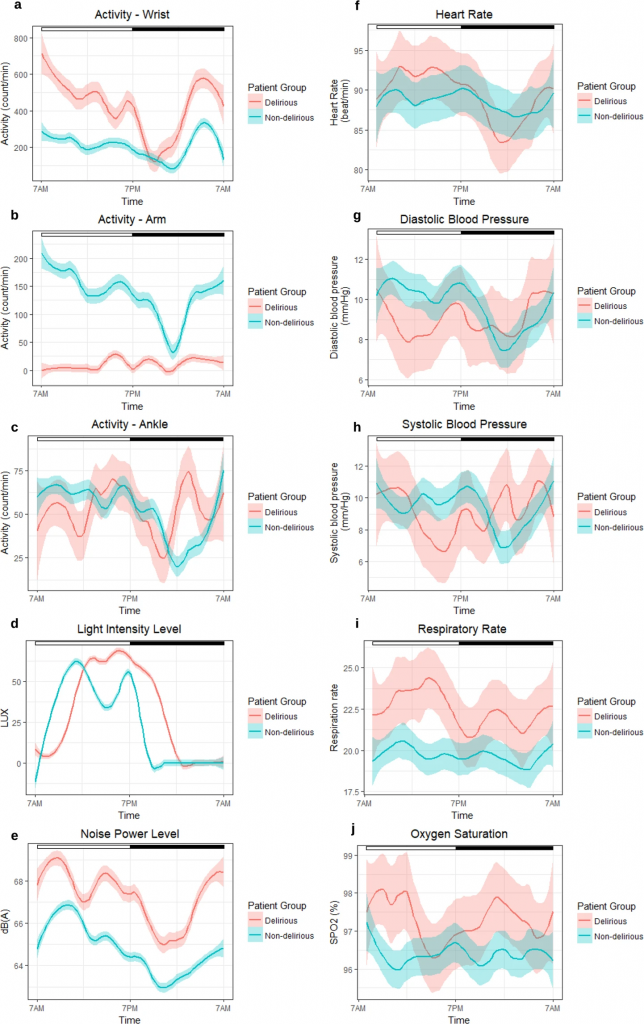ICU患者モニタリングにAIは有効か(AI×医療)【論文】
(Featured AI and healthcare) Can automatic monitoring be done with AI ? Analysis for ICU patients (Publication)
[論文] A. Davoudi, K. R. Malhotra, B. Shickel, S. Siegel, S. Williams, M. Ruppert, E. Bihorac, T. Ozrazgat-Baslanti, P. J. Tighe, A. Bihorac and P. Rashidi, “Intelligent ICU for Autonomous Patient Monitoring Using Pervasive Sensing and Deep Learning”. Scientific Reports, 9, 8020 (2019).
[DOI: 10.1038/s41598-019-44004-w]
3つの要点
✔️本研究では、センシング技術とAIを利用して、ICU患者のモニタリングを自動で行うことが実現可能かどうかを調べた。
✔️ 顔の表情や四肢の動き、さらに光や音圧レベル見舞いの頻度などにおけるデータが、妄想患者と非妄想患者の間で有意に異なることが明らかになった 。
✔️非侵襲的システムでのモニタリングは実現可能であることが示され、この結果は看護師の負担軽減や治療コストの削減につながると期待される。
概説
現在、多くの救命救急指標はきめ細かいレベルで自動的に取り込まれるのではなく、むしろ多くの仕事を抱えた看護師が繰り返し評価している。
このパイロットスタディでは、集中治療室(Intensive Care Unit;ICU)での自律的かつ詳細なモニタリングを行うにあたり、広範のセンシング技術と人工知能(Artificial Intelligence;AI)を使用することの実現可能性を調査した。
代表的な流行状態として、我々は妄想患者とその環境を特徴づけた。
ウェアラブルセンサー、光と音のセンサー、カメラを使用して、患者とその環境に関するデータを収集した。
患者の顔、姿勢、顔の動く部位と表情、頭の姿勢の変化、四肢の動き、音圧レベル、光強度レベル、および見舞いの頻度を検出・認識するために、集めたデータを分析した。
我々は、顔の表情、四肢の動きと姿勢を伴う機能的状態、ならびに夜間の見舞いの頻度、光および音圧レベルを含む環境的要素が、妄想患者と非妄想患者との間で有意に異なることを見出した。
この結果は、重症患者とその環境の自律的かつ詳細なモニタリングが非侵襲的システムを使用して実行可能であることを示し、そして救急患者と環境的要素の特徴づけにおける可能性を証明した。

センサーデータは、手首、腕、足首に記録された加速度計データ、ならびに患者のベッドの後ろの壁に設置したiPodを使用した音圧レベル、アクチグラフを使用して記録された光強度レベル、および心拍数、収縮期血圧、拡張期血圧、呼吸数、酸素飽和度などの生理的データを含んでいる。
平均的な妄想性患者は、平均心拍数、酸素飽和度、および呼吸数、潜在的な呼吸困難や興奮の徴候において、非妄想性患者より高い値を示した。妄想性患者の収縮期血圧および拡張期血圧は、夕方の時間帯は非妄想性患者より低かった。
著者
Anis Davoudi (Department of Biomedical Engineering, University of Florida, Gainesville, 32611, FL, USA)
Kumar Rohit Malhotra (Department of Computer and Information Science and Engineering, University of Florida, Gainesville, 32611, FL, USA)
Benjamin Shickel (Department of Computer and Information Science and Engineering, University of Florida, Gainesville, 32611, FL, USA)
Scott Siegel (Department of Biomedical Engineering, University of Florida, Gainesville, 32611, FL, USA)
Seth Williams (Department of Medicine, University of Florida, Gainesville, 32611, FL, USA / Precision and Intelligent Systems in Medicine (PrismaP), University of Florida, Gainesville, 32611, FL, USA)
Matthew Ruppert (Department of Medicine, University of Florida, Gainesville, 32611, FL, USA / Precision and Intelligent Systems in Medicine (PrismaP), University of Florida, Gainesville, 32611, FL, USA)
Emel Bihorac (Department of Medicine, University of Florida, Gainesville, 32611, FL, USA / Precision and Intelligent Systems in Medicine (PrismaP), University of Florida, Gainesville, 32611, FL, USA)
Tezcan Ozrazgat-Baslanti (Department of Medicine, University of Florida, Gainesville, 32611, FL, USA / Precision and Intelligent Systems in Medicine (PrismaP), University of Florida, Gainesville, 32611, FL, USA)
Patrick J. Tighe (Department of Anesthesiology, University of Florida, Gainesville, 32611, FL, USA)
Azra Bihorac † (Department of Medicine, University of Florida, Gainesville, 32611, FL, USA / Precision and Intelligent Systems in Medicine (PrismaP), University of Florida, Gainesville, 32611, FL, USA)
Parisa Rashidi † (Department of Biomedical Engineering, University of Florida, Gainesville, 32611, FL, USA / Department of Computer and Information Science and Engineering, University of Florida, Gainesville, 32611, FL, USA / Precision and Intelligent Systems in Medicine (PrismaP), University of Florida, Gainesville, 32611, FL, USA)
† These authors contributed equally to this manuscript.
出版情報
Received: 21 August 2018 / Accepted: 07 May 2019 / Published: 29 May 2019
Open Access This article is licensed under a Creative Commons Attribution 4.0 International License, which permits use, sharing, adaptation, distribution and reproduction in any medium or format, as long as you give appropriate credit to the original author(s) and the source, provide a link to the Creative Commons license, and indicate if changes were made. The images or other third party material in this article are included in the article’s Creative Commons license, unless indicated otherwise in a credit line to the material. If material is not included in the article’s Creative Commons license and your intended use is not permitted by statutory regulation or exceeds the permitted use, you will need to obtain permission directly from the copyright holder. To view a copy of this license, visit http://creativecommons.org/licenses/by/4.0/.
■サポートのお願い
AIDBを便利だと思っていただけた方に、任意の金額でサポートしていただけますと幸いです。






 PAGE TOP
PAGE TOP